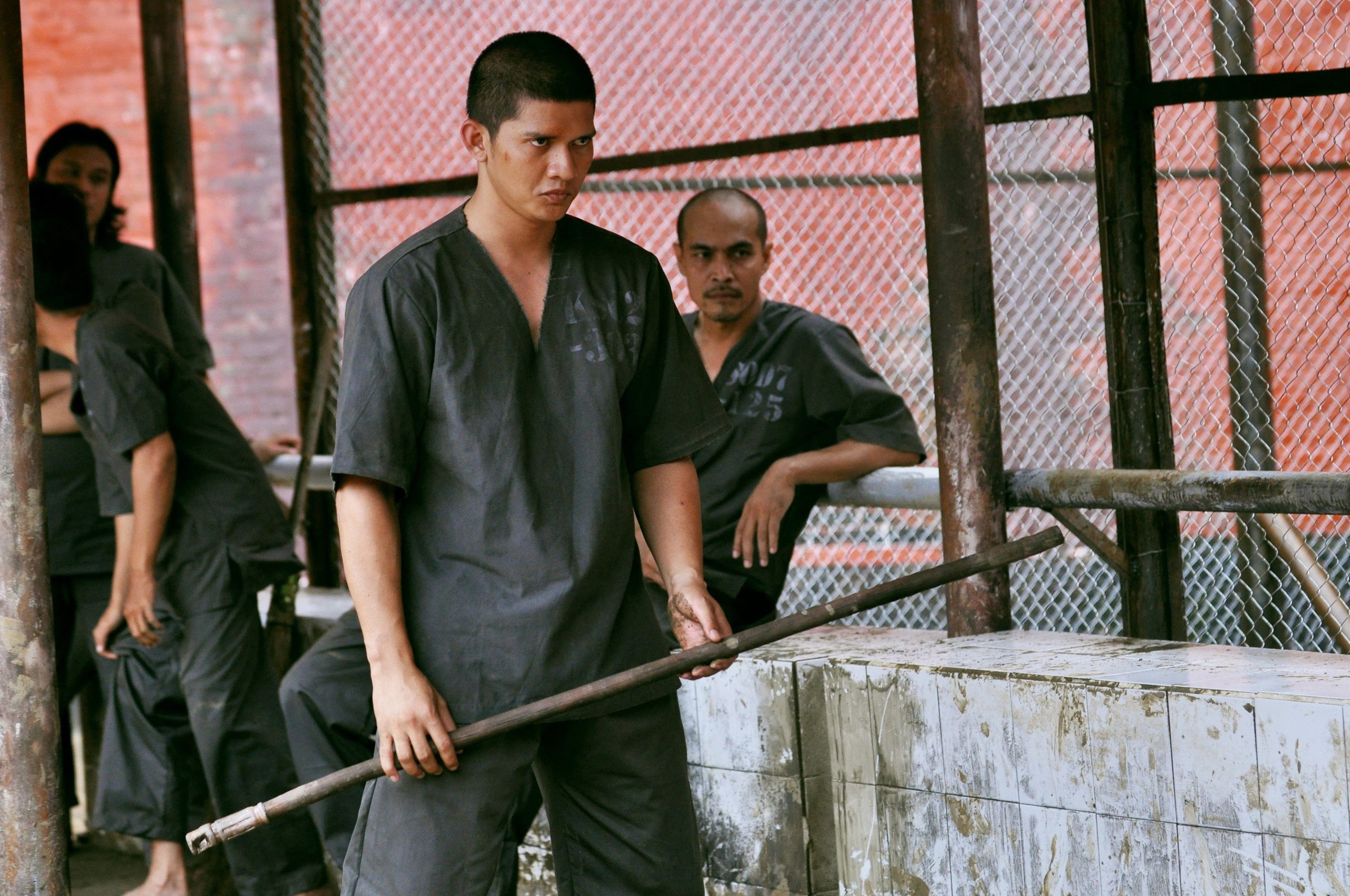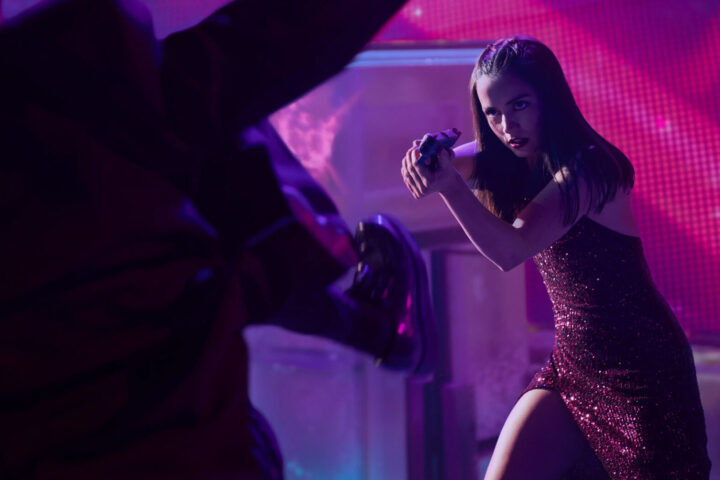The Raid 2: Berandal (meaning thug), is quite an accomplished movie, and one that took me by complete surprise. If you saw 2012’s The Raid, the scrappy story of two Jakarta SWAT cops who took down a cabal of drug pushers holed up in an apartment complex, you knew that director Gareth Evans and star Iko Uwais would bring the manic gusto and inventive fight choreography, a rigorous ballet of grit, if you will, to their new chapter.
But at 2.5 hours, the The Raid 2 is a more expansive, elaborate and fully realized, supersized thing—at once a collection of some of the best martial arts sequences ever onscreen and a stylish mafia family tale of classical themes told on a large canvas, equal parts mania and elegance. It also has lush and beautiful scenes of ugly things, like an assembly line execution in a posh, plush, red velvet restaurant dining room. The Raid 2 is filled with such memorable visions, including two vivid new assassins who say nothing but dispatch with ferocity—one a femme fatale with a claw hammer; the other, a deceptive, hoodied killer adept with a baseball bat.
I recently caught up with director Gareth Evans and star Iko Uwais to chat about their new collaboration, the most entertaining film so far this year, and its ambitious agenda.
I enjoyed The Raid: Redemption as a well-made genre movie and the choreography and sustained energy was really terrific. However, I was a bit broadsided by The Raid 2: Berandal, because this one struck me as a real epic. First, it is technically superb and the sets and sequences are really exciting. But it felt, to me, like The Godfather in a sense because the mafia machinations are so intricate and given so much time and care. It is an A-list film, not a genre one. I know you wanted to make this film before The Raid: Redemption, but ended up shooting it second.
Gareth Evans: Thank you! Yes! So we finished Merantau in 2009 and started right out on Berandal, which was about an ordinary guy who went to prison and befriended the son of a mob boss, and when he came out he became an enforcer for them. But it was missing the investigation. After two years of trying to find funding for it, which we could not get, we decided to do something else. So we started The Raid, and after that I said, ‘What was wrong with our other one? Why doesn’t the character just leave? And what if we made it an extension of The Raid?’ So I went back and rewrote the script and added an additional thirty pages. The idea of making it expansive as you said was that I didn’t want to do a carbon copy of the first. So I wanted to do something that could be a stand-alone thing. You do have to know the universe of the first one to a certain degree especially in the first ten minutes, but after that it exists on its own legs.
Yet our hero, Rama, is still fighting for good even though he is in an even darker and dirtier world. Iko, what are your thoughts on the expansion of this character? He has much more going on.
Iko Uwais: Yes. Not just the fighting was bigger, but the drama was bigger too. I was used to the fighting from the first movie, but here the emotions were bigger for me.
I was surprised by them. For example, there is a scene on where Rama is on the telephone and it is quite touching in its simplicity. He stands still and the camera moves around him.
GE: Right. In the first movie he treated performance like you would treat choreography. The character was so stoic and procedural that it was hard to have a range of emotions. In this one it was totally different. From a performance level, the scene you mentioned is my favorite that he has ever done. We talked about it a lot. One of the hardest things for him, as you said, was that the camera does turn around him and come back.
And he still has to deliver the emotions even when we are seeing just the back of his head.
GE: Yes. In a split second, he has to go from angry to bitter to shocked, and then, in a split second, refocus to soft and tender, realizing that he has to make the most important phone call he has made in three years. And so it was a big ask for him from a performance level. And hearing that child’s voice was big. And now Iko has a child, and I have a little girl as well, and I know what it is like to be away from her for a long time doing promos. So I could jump into his head on that one: ‘You have not seen your baby yet. You want to know that it okay, safe and yours, that you will look after it for the rest of your life. What if you cannot see that kid for the rest of your life?’ That was a great moment and I loved shooting it. There are things that he does—little, tiny cracks and gestures of his performance—that are all him doing that.
One of the things that most impressed me in the film is the attention you give to the impact of combat and the limits of the human body, and what it is capable of doing. I know Iko choreographed much of his work.
GE: Yes, all of it.
Iko, can you describe your approach to martial arts? I know you have been involved since age five. And perhaps any thoughts on the challenges of this movie, including that seven-minute combat sequence?
IU: I mix choreography with his experience and what I learned from my training. For the seven-minute fighting scene, I fought with someone who knew Silat also, so I prepared everything from that experience. At times, it was a challenge because sometimes I was fighting with someone who didn’t know Silat, and was different in that sense, but it was like a game of chess.
GE: Many of these guys know each other in their circle, and have strong reputations amongst the people who know Silat. So when it came time for the two of them to fight each other, they knew it would be the ultimate between them. It was a very close power shift back and forth during that long sequence.
One notable aspect in your action sequences is the human component, specifically the affect of trauma on the human body. For example, in the car sequence, we are less focused on the vehicles and more so on the participants, who are hanging from windows, struck by doors, thrown around inside the front and back.
GE: I am so glad you are saying this! Joe Taslim, one of the stars of the first movie, went off to do Fast and Furious 6, and when it was coming out in cinemas he was like, ‘You have to go and see my movie!’ I said, ‘Joe, I am not going to see that movie until I have done my car chase first. When I finish, I will watch yours!’ He said, ‘Why?’ I said, ‘Because I have seven cars total to last me seven minutes. You ran over six—in a tank—in ten seconds. I can’t do the level of destruction you guys did.’ I felt like exactly what you said, that I wanted to focus on the impact of the bodies inside the car.
And the ones outside it—one goes through the window, and then the car goes through the door and strikes another one that is pinned to a wall.
GE: Yes, exactly. Because usually when a car crashes in a film it is all metal and glass. I wanted to show what happens to the person—when they get knocked out, the body flies and they hit a wall. So one top angle shot. So the whole point of the car chase was wanting to have these wide, expansive feelings of cars screeching down the road, but then inside as well. When there would be a bump it would be choreography, the same way that they would block and punch. The cars were scrapping away, chipping away. We did the sound at Skywalker Ranch and they did a great job. But the whole idea was that expansive stuff and then the claustrophobic, tight spaces in the back of the car. I felt sorry for Iko because he was gathering all of these people in the car—it was a real car—and he was fighting all over inside it, and would say, ‘I can’t do this piece of choreography!’ But he did.
And he also moves from the front seat to the backseat and then out the window.
GE: Exactly! In those moments when he would get pulled from the front seat to the back, nine times out of ten he would whack his head on the mirror or something because it was so tight. But two guys having to reload their guns and see who would get there first, while they are driving down the street, was like a Western moment in a car chase.
Where do you want to take this character in the next movie?
GE: Okay, that’s good! We want to do a third one, and all I can say right now is that the basic idea is that just as part two takes place two hours after the first film, part three would take place two to three hours before The Raid 2 finished. So we are going to go back to another scene where a decision gets made by a certain group of people that will spark off a whole bunch of new stuff!



